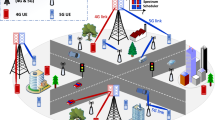Abstract
The initial definition of the Proportional Fair scheduling was based on a transmission rate criterion. However, a Signal-to-Noise Ratio (SNR) based definition is commonly used by researchers due to its mathematical tractability, based on the assumption that the performance of both definitions is equivalent. In this work, we derive closed-form expressions for the probability density function of the system output SNR (i.e. received SNR based on the selected scheduling algorithm) and the per-user SNR over Rayleigh fading channels when a rate-based criterion is used. Additionally, we analyze the common assumption of equivalence between both criteria by comparing their per-user performance. Our analysis reveals that their performance are only similar when users experience high values of average SNR. However, significant differences in terms of user fairness have been found in the lower SNR regime.





Similar content being viewed by others
References
Entrambasaguas, J. T. (2007). Multiuser capacity and fairness of channel/QoS-aware multiplexing algorithms. IEEE Network, 21(3), 24–30.
Viswanath, P., Tse, D. N. C., & Laroia, R. (2002). Opportunistic beamforming using dumb antennas. IEEE Transactions on Information Theory, 48(6), 1277–1294.
Shakkottai, S., & Stolyar, A. L. (2001). Scheduling algorithms for a mixture of real-time and non-real-time data in HDR. In Proceedings of 17th international teletraffic congress (vol. 4, pp. 793-804).
Valkova-Jarvis, Z. V., & Stoynov, V. R. (2017). Novel throughput quantile averaging methods for the proportional fair algorithm in indoor mobile networks. In 2017 advances in wireless and optical communications (RTUWO), Riga (pp. 198-202).
Liu, E., & Leung, K. (2010). Expected throughput of the proportional fair scheduling over Rayleigh fading channels. IEEE Communications Letters, 14(6), 515–517.
Pérez, J. (2009). Performance analysis of SNR-based scheduling policies in asymmetric broadcast ergodic fading channel. EURASIP Journal on Wireless Communications and Networking, 8, 1–6.
Yang, L., & Alouini, M.-S. (2006). Performance analysis of multiuser selection diversity. IEEE Transactions on Vehicular Technology, 55(6), 1848–1861.
Parruca, D., Grysla, M., Gortzen, S., & Gross, J. (2013). Analytical model of proportional fair scheduling in interference-limited OFDMA/LTE networks. In 2013 IEEE 78th vehicular technology conference (VTC Fall) (pp. 1–7). Las Vegas, NV.
Kang, M., Sang, Y. J., Hwang, H. G., Lee, H. Y., & Kim, K. S. (2009). Performance analysis of proportional fair scheduling with partial feedback information for multiuser multicarrier systems. In VTC Spring 2009 - IEEE 69th vehicular technology conference, Barcelona (pp. 1–5).
Senst, A., Rittich, P. S., Ascheid, G., & Meyr, H. (2004). On the throughput of proportional fair scheduling with opportunistic beamforming for continuous fading states. In Proceedings of IEEE vehicular technology conference (VTC) (Vol. 1, pp. 300–304). Los Angeles, CA.
Sharma, N., & Ozarow, L. H. (2005). A study of opportunism for multiple-antenna systems. IEEE Transactions on Informations Theory, 51(5), 1804–1814.
Yang, L., Kang, M., & Alouini, M.-S. (2007). On the capacity-fairness tradeoff in multiuser diversity systems. IEEE Transactions on Vehicular Technology, 56(4), 1901–1907.
Tabassum, H., Yilmaz, F., Dawy, Z., & Alouini, M. S. (2012). On the modeling of uplink inter-cell interference based on proportional fair scheduling. In 2012 IEEE wireless communications and networking conference workshops (WCNCW), Paris (pp. 317–321).
Parruca, D., & Gross, J. (2016). Throughput analysis of proportional fair scheduling for sparse and ultra-dense interference-limited OFDMA/LTE networks. IEEE Transactions on Wireless Communications, 15, 6857–6870.
Günter, C. G. (1996). Comment on “Estimate of channel capacity in Rayleigh fading environment”. IEEE Transactions on Vehicular Technology, 45(2), 401–403.
IST-WINNER II Deliverable 1.1.2 v.1.2, “WINNER II Channel Models”, IST-WINNER2, Tech. Rep., (2007) (available online: http://www.cept.org/files/1050/documents/winner2%20-%20final%20report.pdf).
Acknowledgements
This work has been partially supported by the Spanish Government (Ministerio de Economía y Competitividad) under grant TEC2016-80090-C2-1-R, and by the University of Málaga.
Author information
Authors and Affiliations
Corresponding author
Additional information
Publisher's Note
Springer Nature remains neutral with regard to jurisdictional claims in published maps and institutional affiliations
Rights and permissions
About this article
Cite this article
Delgado-Luque, I.M., Aguayo-Torres, M.C., Gómez, G. et al. SNR- Versus Rate-Based Proportional Fair Scheduling in Rayleigh Fading Channels. Wireless Pers Commun 106, 2099–2111 (2019). https://doi.org/10.1007/s11277-018-5928-6
Published:
Issue Date:
DOI: https://doi.org/10.1007/s11277-018-5928-6




